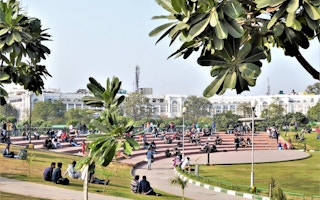Even as people crowd into the cities, they don’t crowd the way they used to, and urban space demands are increasing. Even in some of the developing nations, townspeople are demanding more elbow-room.
And in the last four decades, worldwide, humans have claimed around 125,000 square kilometres of farmland or wilderness more than would have been necessary if urban densities had stayed at the 1970 level.
That is: to accommodate today’s city-dwellers with more space than their parents and grandparents ever expected to enjoy, an additional area almost the size of Greece has been covered by asphalt, brick, concrete, tile and glass.
In the US, urban settlements have always been fringed by more roomy suburban developments. Now in China, India and Nigeria, the cities are expanding and the population densities are decreasing.
Risk to farmers
“These three countries are expected to account for more than a third of the projected increase in the world’s urban population by 2050,” said Burak Güneralp, a geographer at Texas A&M University in the US.
“They also still have many millions of small farmers earning their livelihoods working fertile lands on the outskirts of cities. Thus any loss of these high-quality lands to urban expansion has huge implications for the livelihoods of these farmers.”
Dr Güneralp and colleagues report in the journal Environmental Research Letters that they looked at 611 case studies of 330 urban centres to calculate population growth, urban expansion and urban population densities between 1970 – the earliest moment for reliable statistics – and 2010.
They also factored in the size of cities, to distinguish different rates of change in centres with more and with fewer than two million citizens.
Once most of humanity lived in rural areas. Now more than half the planet is crowded into cities and townships, and in a few decades the proportion could reach two-thirds.
But this crowding creates new problems. Cities are always significantly hotter than the surrounding landscape, and as global average temperatures rise, this in turn is likely to accelerate energy demand and global heating as people are forced to install air-conditioning.
The concentration of people in cities is likely to create new demands on sometimes precarious water supplies, and in any case the combination of climate change and population growth means ever greater numbers are at hazard from drought or flood.
All of this in turn increases the pressure for green spaces within the new cities and a more spacious lifestyle.
Cheek by jowl
But civilised city life comes at an environmental price. About half of India’s land is already classified as “degraded”, while India has the largest rural population but also the steepest fall in what geographers call urban land use efficiency, and the rest of the world calls living on top of your neighbours.
“Our findings suggest that decreasing urban population densities in India and Nigeria since 1970 caused 85 per cent and 30 per cent more land, respectively, to be converted to urban,” Dr Güneralp said.
“Furthermore, small-medium cities in India, China, South-east Asia, Africa and Europe are following in the footsteps of the United States in declines in urban densities.
“These findings are important, because globally, it is these small-medium-sized cities with limited institutional and financial capacity that are growing the fastest.”
This story was published with permission from Climate News Network.










